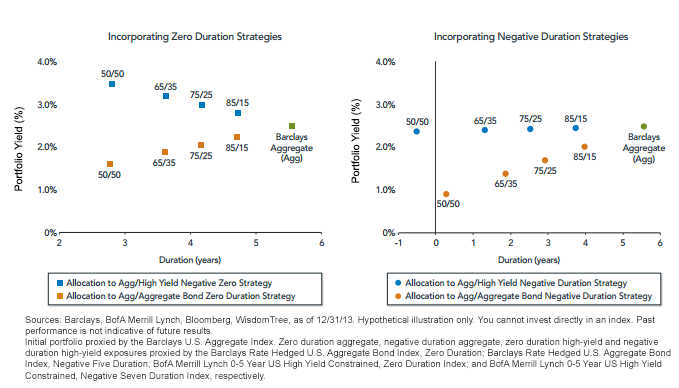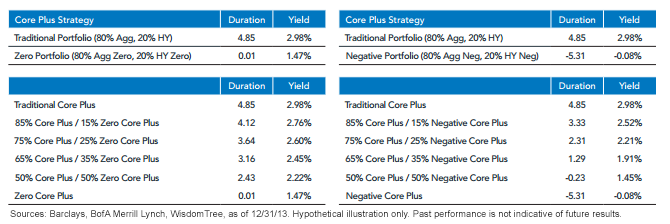Managing Risk with Zero and Negative Duration Bond Portfolios


 Real-World Applications
While the Barclays Aggregate could serve as a rough approximation of a hypothetical bond portfolio, many investors have extended beyond the index’s investment-grade universe to incorporate satellite positions in high-yield corporate bonds. In recent years, so-called “core plus” strategies have been employed successfully by money managers as a way to potentially add value to investors’ portfolios. Ultimately, these strategies seek to balance income and credit risk in order to generate total returns. By constructing these hypothetical portfolios using zero duration and negative duration tools as shown below, advisors can further refine their specific exposure not only to credit risk but to a specific level of interest rate risk as well.
Real-World Applications
While the Barclays Aggregate could serve as a rough approximation of a hypothetical bond portfolio, many investors have extended beyond the index’s investment-grade universe to incorporate satellite positions in high-yield corporate bonds. In recent years, so-called “core plus” strategies have been employed successfully by money managers as a way to potentially add value to investors’ portfolios. Ultimately, these strategies seek to balance income and credit risk in order to generate total returns. By constructing these hypothetical portfolios using zero duration and negative duration tools as shown below, advisors can further refine their specific exposure not only to credit risk but to a specific level of interest rate risk as well.
 Ultimately, we believe our latest suite of rising rate tools provide advisors with an opportunity to harness institutional asset management in an easily tradable ETF wrapper. Although rates in the United States have pulled back to start the year, we believe that they will likely rise as the snow melts, resulting in a potential headwind for traditional fixed income portfolios. In our view, the zero and negative duration strategies offer another tool for investors to better insulate their portfolios against a rising rate environment.
Ultimately, we believe our latest suite of rising rate tools provide advisors with an opportunity to harness institutional asset management in an easily tradable ETF wrapper. Although rates in the United States have pulled back to start the year, we believe that they will likely rise as the snow melts, resulting in a potential headwind for traditional fixed income portfolios. In our view, the zero and negative duration strategies offer another tool for investors to better insulate their portfolios against a rising rate environment.
Important Risks Related to this Article
The WisdomTree Barclays U.S. Aggregate Bond Negative Duration Fund (AGND), WisdomTree Barclays U.S. Aggregate Bond Zero Duration Fund (AGZD), WisdomTree BofA Merrill Lynch High Yield Bond Negative Duration Fund (HYND), and WisdomTree BofA Merrill Lynch High Yield Bond Zero Duration Fund (HYZD) are new and have a limited operating history. You cannot invest directly in an Index. Index performance does not represent actual Fund or portfolio performance. A Fund or portfolio may differ significantly from the securities included in the Index. There are risks associated with investing, including possible loss of principal. Non-investment-grade debt securities (also known as high-yield or “junk” bonds) have lower credit ratings and involve a greater risk to principal. Fixed income investments are subject to interest rate risk; their value will normally decline as interest rates rise. The duration Funds seek to mitigate interest rate risk by taking short positions in U.S. Treasuries, but there is no guarantee this will be achieved. Derivative investments can be volatile, and these investments may be less liquid than other securities, and more sensitive to the effects of varied economic conditions. Fixed income investments are also subject to credit risk, the risk that the issuer of a bond will fail to pay interest and principal in a timely manner or that negative perceptions of the issuer’s ability to make such payments will cause the price of that bond to decline. The Duration Funds may engage in “short sale” transactions of U.S. Treasuries, where losses may be exaggerated, potentially losing more money than the actual cost of the investment, and the third party to the short sale may fail to honor its contract terms, causing a loss to the duration Funds. While the duration Funds attempt to limit credit and counterparty exposure, the value of an investment in the duration Funds may change quickly and without warning in response to issuer or counterparty defaults and changes in the credit ratings of each Fund’s portfolio investments. Investors should anticipate that due to the negative duration target, those Funds will be highly sensitive to interest rate changes. The higher (whether positive or negative) a bond fund’s duration, the greater its sensitivity to interest rates changes, and fluctuations in value, whether positive or negative, will be more pronounced. Investing in mortgage- and asset-backed securities involves interest rate, credit, valuation, extension and liquidity risks and the risk that payments on the underlying assets are delayed, prepaid, subordinated or defaulted on. Due to the investment strategy of certain funds, they may make higher capital gain distributions than other ETFs. Securities with floating rates can be less sensitive to interest rate changes than securities with fixed interest rates, but may decline in value. The issuance of floating rate notes by the U.S. Treasury is new and the amount of supply will be limited. Fixed income securities will normally decline in value as interest rates rise. The value of an investment in the Fund may change quickly and without warning in response to issuer or counterparty defaults and changes in the credit ratings of the Fund’s portfolio investments. Please read each Fund’s prospectus for specific details regarding each Fund’s risk profile. Barclays Capital Inc. and its affiliates (“Barclays”) are not the issuer or producer of the Funds, and Barclays has no responsibilities, obligations or duties to investors in the Funds. These Barclays Indexes are a trademark owned by Barclays Bank PLC and licensed for use by WisdomTree with respect to the WisdomTree trust as the issuer of the Funds. Barclays’ only relationship with WisdomTree is the licensing of these Barclays Indexes, which is determined, composed and calculated by Barclays without regard to WisdomTree or the Funds. While WisdomTree may for itself execute transaction(s) with Barclays in or relating to these Barclays Indexes in connection with the Funds that investors acquire from WisdomTree, investors in the Funds neither acquire any interest in these Barclays Indexes nor enter into any relationship of any kind whatsoever with Barclays upon making an investment in the Funds. The Funds are not sponsored, endorsed, sold or promoted by Barclays, and Barclays makes no representation or warranty (express or implied) to the owners of the Funds, the issuer or members of the public regarding the advisability, legality or suitability of the Funds or use of these Barclays Indexes or any data included therein. Barclays shall not be liable in any way to the issuer, investors or to other third parties in respect of the use or accuracy of these Barclays Indexes or any data included therein or in connection with the administration, marketing, purchasing or performance of the Funds. Merrill Lynch, Pierce, Fenner & Smith Incorporated and its affiliates (“BofA Merrill Lynch”) indexes and related information, the name “BofA Merrill Lynch” and related trademarks are intellectual property licensed from BofA Merrill Lynch and may not be copied, used or distributed without BofA Merrill Lynch’s prior written approval. The licensee’s products have not been passed on as to their legality or suitability and are not regulated, issued, endorsed, sold, guaranteed or promoted by BofA Merrill Lynch. BOFA MERRILL LYNCH MAKES NO WARRANTIES AND BEARS NO LIABILITY WITH RESPECT TO THE INDEXES, ANY RELATED INFORMATION, ITS TRADEMARKS OR THE PRODUCT(S) (INCLUDING, WITHOUT LIMITATION, THEIR QUALITY, ACCURACY, SUITABILITY AND/OR COMPLETENESS). ALPS Distributors, Inc., is not affiliated with BofA Merrill Lynch or Barclays.

Rick Harper serves as the Chief Investment Officer, Fixed Income and Model Portfolios at WisdomTree Asset Management, where he oversees the firm’s suite of fixed income and currency exchange-traded funds. He is also a voting member of the WisdomTree Model Portfolio Investment Committee and takes a leading role in the management and oversight of the fixed income model allocations. He plays an active role in risk management and oversight within the firm.
Rick has over 29 years investment experience in strategy and portfolio management positions at prominent investment firms. Prior to joining WisdomTree in 2007, Rick held senior level strategist roles with RBC Dain Rauscher, Bank One Capital Markets, ETF Advisors, and Nuveen Investments. At ETF Advisors, he was the portfolio manager and developer of some of the first fixed income exchange-traded funds. His research has been featured in leading periodicals including the Journal of Portfolio Management and the Journal of Indexes. He graduated from Emory University and earned his MBA at Indiana University.

